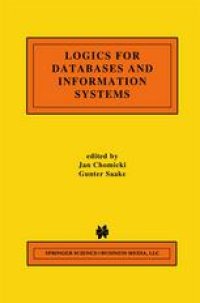
Ebook: Logics for Databases and Information Systems
- Tags: Data Structures Cryptology and Information Theory, Artificial Intelligence (incl. Robotics), Programming Languages Compilers Interpreters, Information Storage and Retrieval
- Series: The Springer International Series in Engineering and Computer Science 436
- Year: 1998
- Publisher: Springer US
- Edition: 1
- Language: English
- pdf
Time is ubiquitous in information systems. Almost every enterprise faces the problem of its data becoming out of date. However, such data is often valu able, so it should be archived and some means to access it should be provided. Also, some data may be inherently historical, e.g., medical, cadastral, or ju dicial records. Temporal databases provide a uniform and systematic way of dealing with historical data. Many languages have been proposed for tem poral databases, among others temporal logic. Temporal logic combines ab stract, formal semantics with the amenability to efficient implementation. This chapter shows how temporal logic can be used in temporal database applica tions. Rather than presenting new results, we report on recent developments and survey the field in a systematic way using a unified formal framework [GHR94; Ch094]. The handbook [GHR94] is a comprehensive reference on mathematical foundations of temporal logic. In this chapter we study how temporal logic is used as a query and integrity constraint language. Consequently, model-theoretic notions, particularly for mula satisfaction, are of primary interest. Axiomatic systems and proof meth ods for temporal logic [GHR94] have found so far relatively few applications in the context of information systems. Moreover, one needs to bear in mind that for the standard linearly-ordered time domains temporal logic is not re cursively axiomatizable [GHR94]' so recursive axiomatizations are by necessity incomplete.
Content:
Front Matter....Pages i-xiii
Introduction to Logics for Databases and Information Systems....Pages 1-4
A Logic Primer....Pages 5-30
Temporal Logic in Information Systems....Pages 31-70
The Role of Deontic Logic in the Specification of Information Systems....Pages 71-115
A Logic for Programming Database Transactions....Pages 117-166
Logics for Specifying Concurrent Information Systems....Pages 167-198
Evolving Logical Specification in Information Systems....Pages 199-228
Description Logics for Conceptual Data Modeling....Pages 229-263
Integrity Constraints: Semantics and Applications....Pages 265-306
Logical Approaches to Incomplete Information: A Survey....Pages 307-356
Declarative Frameworks for Inheritance....Pages 357-388
On Logical Foundations of Active Databases....Pages 389-422
Back Matter....Pages 423-430
Content:
Front Matter....Pages i-xiii
Introduction to Logics for Databases and Information Systems....Pages 1-4
A Logic Primer....Pages 5-30
Temporal Logic in Information Systems....Pages 31-70
The Role of Deontic Logic in the Specification of Information Systems....Pages 71-115
A Logic for Programming Database Transactions....Pages 117-166
Logics for Specifying Concurrent Information Systems....Pages 167-198
Evolving Logical Specification in Information Systems....Pages 199-228
Description Logics for Conceptual Data Modeling....Pages 229-263
Integrity Constraints: Semantics and Applications....Pages 265-306
Logical Approaches to Incomplete Information: A Survey....Pages 307-356
Declarative Frameworks for Inheritance....Pages 357-388
On Logical Foundations of Active Databases....Pages 389-422
Back Matter....Pages 423-430
....